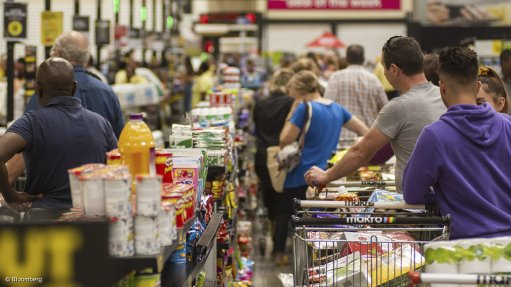Sector expected to grow from ICT trade
Market research organisation Kenneth Research last month released a report which showed that the petrochemicals and polymers market is anticipated to grow, primarily on the growth in trade of information and communication technology (ICT) goods and services globally.
The report emphasises the latest trends, key opportunities, drivers and challenges associated with the growth of the market during the forecast period of 2022 to 2031.
According to the statistics by finance organisation the World Bank, the export of ICT goods globally increased from 11.16% of total goods exports in 2017 to 11.53% of total goods exports in 2019.
In a release on May 4 last year, the US Bureau of Economic Analysis and US Census Bureau mentioned the recovery in US international trade in March 2021. Exports in the country reached $200-billion, up by $12.4-billion in February 2021.
Following the continuous incremental trend, imports tallied $274.5-billion, picking up by $16.4-billion in February 2021.
As Covid-19, however, still haunts economies globally, year-over-year average exports in the US declined by $7.0-billion from March 2020 till March 2021, while imports increased by $20.7-billion during the same time. This shows how the market is trying to recover and this will have a direct impact on the healthcare, information and communication technologies and chemical industries, creating a significant demand for petrochemicals and polymers market products.
Moreover, amongst all the continents that used pesticides, Asia registered as the largest user of pesticides, attaining a share of 52.4% in the year 2018. It was followed by the Americas, Europe, Africa and Oceania with 32.3%, 11.6%, 2% and 1.7% respectively. The statistics also stated that China was the largest user of pesticides worldwide, using 1763 000 t of pesticides for agricultural use.
Polyurethane is polymer made from monomer units of urethane (carbamate). Polyurethanes are versatile material which can be converted into various forms such as thermosetting plastics, thermoplastics and synthetic rubber (elastomer). Most of polyurethanes are thermosetting plastics which do not melt when heated.
Most commonly polyurethanes are made by the reaction of polyol and polyisocyanate. Commercially methylene diphenyl diisocyanate (MDI) and diisocyanate (TDI) are used for production of polyurethanes.
Different types of polyurethanes are available in the market, such as flexible polyurethane foam, rigid polyurethane foam, thermoplastic polyurethanes and polyurethane binders, and are used for a variety of applications such as automotive; building and construction; footwear; furniture and bedding; electronics and many other applications.
Raw materials used for the production of polyurethanes are polyol and isocynates. These materials are petrochemicals which are derived from crude oil. TDI and MDI are the commonly used isocynates in the market.
There are many large players in the MDI, TDI and polyol market such as BASF, Bayer, Dow Chemicals, Sadara group.
Supply of raw material is a factor for the production of polyurethanes. In the market there is oversupply of the raw materials, and the market is competitive. Asia Pacific is the largest supplier of raw material for the production of polyurethanes.
While there are no concerns with supply of the raw material, the price of raw materials is not stable due to fluctuation in the crude oil price. These raw material prices are derived from crude oil, making the fluctuation in oil price a significant concern.
The two major application areas that show significant benefits in terms of energy efficiency from polyurethane are construction and transportation.
In building and construction, use of polyurethane in polyurethane roof and wall insulation, wall and window insulation and pipe insulation ensures that temperatures are maintained. Use of polyurethane in cars and trucks leads to a reduction in vehicle weight, and therefore provides greater fuel economy. Polyurethane thermal insulation in refrigerators, freezers, water heaters and other such appliances ensures these units use less energy.
Comments
Press Office
Announcements
What's On
Subscribe to improve your user experience...
Option 1 (equivalent of R125 a month):
Receive a weekly copy of Creamer Media's Engineering News & Mining Weekly magazine
(print copy for those in South Africa and e-magazine for those outside of South Africa)
Receive daily email newsletters
Access to full search results
Access archive of magazine back copies
Access to Projects in Progress
Access to ONE Research Report of your choice in PDF format
Option 2 (equivalent of R375 a month):
All benefits from Option 1
PLUS
Access to Creamer Media's Research Channel Africa for ALL Research Reports, in PDF format, on various industrial and mining sectors
including Electricity; Water; Energy Transition; Hydrogen; Roads, Rail and Ports; Coal; Gold; Platinum; Battery Metals; etc.
Already a subscriber?
Forgotten your password?
Receive weekly copy of Creamer Media's Engineering News & Mining Weekly magazine (print copy for those in South Africa and e-magazine for those outside of South Africa)
➕
Recieve daily email newsletters
➕
Access to full search results
➕
Access archive of magazine back copies
➕
Access to Projects in Progress
➕
Access to ONE Research Report of your choice in PDF format
RESEARCH CHANNEL AFRICA
R4500 (equivalent of R375 a month)
SUBSCRIBEAll benefits from Option 1
➕
Access to Creamer Media's Research Channel Africa for ALL Research Reports on various industrial and mining sectors, in PDF format, including on:
Electricity
➕
Water
➕
Energy Transition
➕
Hydrogen
➕
Roads, Rail and Ports
➕
Coal
➕
Gold
➕
Platinum
➕
Battery Metals
➕
etc.
Receive all benefits from Option 1 or Option 2 delivered to numerous people at your company
➕
Multiple User names and Passwords for simultaneous log-ins
➕
Intranet integration access to all in your organisation


















